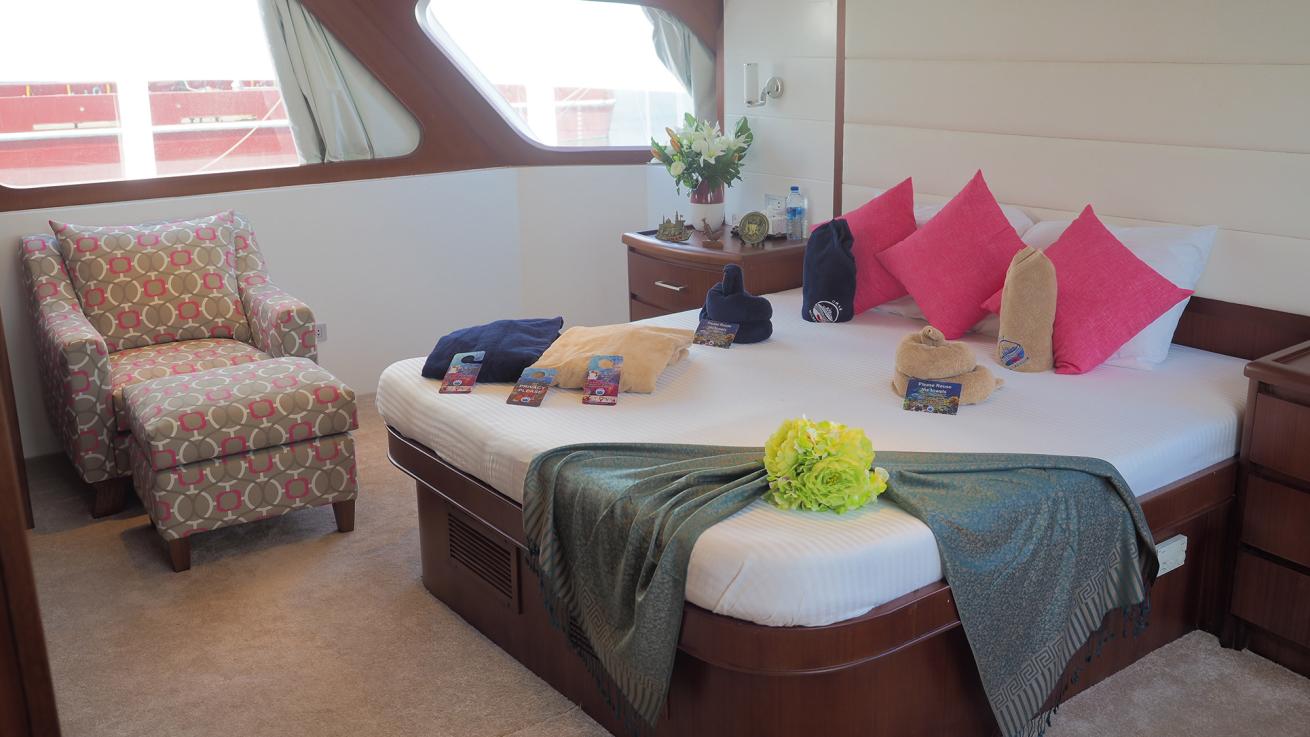30 Liveaboard Etiquette Tips Every Diver Needs to Know

Aggressor LiveaboardsA liveaboard is your floating hotel for your dive vacation. Make sure you behave like a guest who will get invited back.
You’ll be calling your floating hotel home for several days, and you will definitely be spoiled by the valet service, above and below the waves. But there’s more to smooth sailing than a comfortable vessel, calm seas and clear skies. Here’s our advice for having a hassle-free liveaboard experience.
Plan Ahead
- Make sure all your scuba gear is serviced and functioning, and assemble a save-a-dive kit. Pack any spares you might need, including O-rings, camera batteries, spare mask straps, fin straps and other accessories.
- Choose a room when you book, and make sure it meets your needs. If it’s really important for you to have a private cabin with an en suite bathroom, for example, you’ll be miserable sleeping on one of the top bunks in a quad-occupancy berth, no matter how many hammerheads and whale sharks you see. If you’re prone to seasickness, request a cabin that’s located in the middle of the boat.
- Make special menu requests before you board. If you want or require something special — if you’re a vegan, for example — request it well in advance.
- Get nitrox certified. Some itineraries require it, but even if yours doesn’t, you’ll love the additional bottom time.
- Make sure you have the skills necessary for the type of diving. For example, if the diving is going to be from a Zodiac, make sure you’re comfortable making back-roll entries.
- Check the expected water temps and conditions. Ensure you have the appropriate exposure suit protection and gear. For some itineraries, specific gear, such as reef hooks, safety sausages and drysuits, is required. For more packing tips, see “Pack and Go” on page 58 and “Pack Smart” on page 82.
- Get DAN insurance to cover both dive-related and non-dive-related medical emergencies (see page 84). Dive accidents are rare, but when they do happen, treatment can be expensive and is probably not covered by your primary health insurance.
- Get a medical checkup and make sure your immunizations are up to date and that you have the ones required for the locale. Refill prescription medicine, including seasickness medications, and pack a simple first-aid kit, complete with bandages, aspirin, etc.
- Organize all travel and dive documents. Keep in mind that some destinations require that your passport has at least six months left before the expiration date. If the destination requires a visa, find out whether you can get one at the airport upon arrival or whether you need to obtain one before departure. Don’t forget your C-card — either an old-fashioned physical card or e-card. Photocopy or store images on your phone of all documents, front and back.
- Notify your credit-card provider and bank of your travel plans. Make sure U.S. dollars are accepted, and have currency in small denominations for tips and incidental purchases. If you’re planning to make most purchases via credit card — including the final liveaboard payment — find out if credit-card payments are acceptable. Research departure taxes, park fees, etc., before you go so you’re not hit with unexpected expenditures. As with your passport and C-card, make copies of your credit cards; if they get lost or stolen, you’ll appreciate having the info you need to report the loss.
- Do your homework on the region’s culture, especially if you’re spending time in the country or island of your liveaboard’s port. You don’t want to do anything that makes local residents uncomfortable. You might need to get schooled on eating and clothing etiquette, for example.
Get Ready
- Unpack your clothing and other personal items. If you’ve got a roommate, ask them which dresser, side of the closet, and bed they prefer. Find an out-of-the-way place for your luggage or follow the crew’s instructions for storing it elsewhere on the boat. Keep your toiletries accessible but neatly stored in a bag.
- Do not keep wet gear in your cabin unless instructed to do so.
Do your homework on the region’s culture, especially if you’re spending time in the country or island of your liveaboard’s port. You don’t want to do anything that makes the local residents uncomfortable.
- Use the toilet as you would any marine head.
- Either choose or find your assigned gear station. Often, there will be a large bin under the seat — unpack your gear and stow it in the bin.
- Stay organized on the dive deck. Unlike the diver in our illustration on page 78, keep everything neatly stored in your bin, hanging on a designated line or secured on the camera-only table. A dry bag stowed in your bin can hold your sunscreen, sunglasses, flip-flops, hat and après-dive beauty products such as hair conditioner.
- Share outlets and other communal resources in the salon. Recharge items such as your laptop and tablet for only as long as is needed.
- Use the camera table for its intended use — if you’re not a photographer, respect that space, and do not use it for your sunglasses, dive log or water bottle.
Listen up
- Pay attention to all crew-provided briefings, from the vessel’s emergency and safety procedures to the dive-site ones. Most liveaboards have a group meeting on the first evening — it’s a meet-and-greet, but it’s also a time to learn about the vessel’s basic routine and rules.
- Follow the rules. For example, every liveaboard has a procedure for water entries and exits, including its preferred method for having you sign in and out of the water.
- Be on time for every dive briefing and tender loading, so the crew — and other guests — don’t have to wait for you.

Aggressor LiveaboardsThe crew works hard to keep your stateroom clean and fresh. Don't store wet dive gear here.
Pack a Good Attitude
- Try to be friendly with everyone, crew and guests alike. You are all in the same boat — literally — and you’ll have a far more pleasurable trip when you make friends.
- Get to know your dive buddy. This is important for solo travelers. Learn about each other’s experience level and most recent dive. Clarify the signals you will use underwater, and discuss your profile before each dive.
- Make a change if necessary. If you are totally incompatible with your buddy — due to differing skill levels or interests — but are not comfortable telling your buddy you want to be paired with someone else, ask the crew to handle it.
- Be understanding. It can be disappointing when the crew announces a change in plans, so your understanding is appreciated, especially when the decision is for safety reasons.
Use Your Head
- Indulge in happy hour only if you’re not making a night dive. Most liveaboards insist on this, but if not, use common sense. If you make a late-afternoon or night dive, you can always follow it with a cocktail, glass of wine or cold beer.
- Be honest about your air consumption and skill level. If you’re traveling solo, the crew will pair you with someone with the same dive skills.
- Use only as much water as needed; fresh water can be scarce. Use the water-filled buckets on the deck for their intended usage.
Say Thank You
- Leave behind DVDs, books, magazines and games for the crew and future guests. Do you have any unopened toiletry items, such as shampoo, toothpaste or deodorant? Gift these to the crew.
- Tip appropriately at the end of the trip. You probably noticed that most crewmembers pull double- and triple-duty shifts — for example, your divemaster might take a turn serving dinner, leading an evening presentation or helping fill tanks. It’s customary to tip at least 10 percent of the total cost of the trip.










